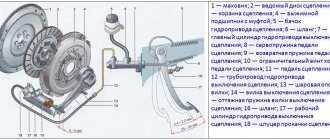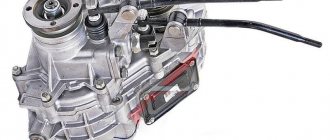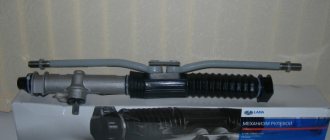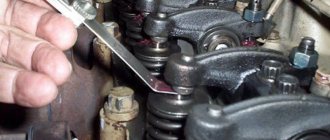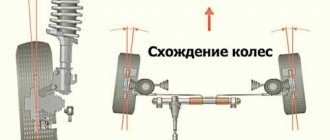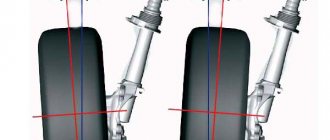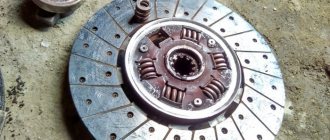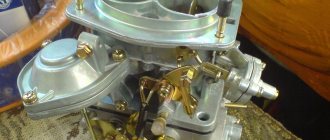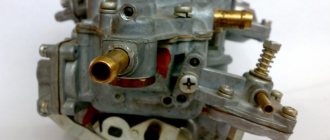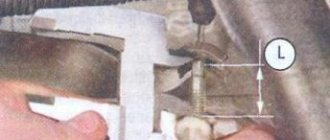How to check the turbine actuator?
When a car engine operates at high speeds, it is important to protect the turbocharger from possible overloads.
To do this, the turbocharging complex is supplemented with an electronic actuator. Essentially, this is a valve capable of releasing exhaust gases escaping to the outside. As a result, excess pressure does not affect the turbocharger.
Types and features of operation of turbine actuators
Actuators are divided into mechanical and electronic. The classic mechanical element operates on the principle of exhaust gas pressure. So, in the standard position, the spring of the device fixes the membrane. As the pressure increases, the valve flap is no longer fixed, and a certain volume of gases escapes past the impeller. In this case, the rotation speed of the turbine is adjusted.
In an electronic turbine actuator, a special engine unit is responsible for control. It receives data from sensors located in different consumable parts. Based on data analysis, the block sends commands to the actuator: close or open the valve.
How can you tell if the actuator is broken?
The main signs of actuator failure are extraneous noise, turbine whistling when you press the gas pedal and turn off the engine, and a decrease in boost power. Usually, electronic elements, electric motor components, drive units, and controllers fail.
Accurate diagnostics of the electronic actuator is possible only in professional factory conditions. To begin with, a service station specialist checks the performance of the actuator using a tester. The test can be carried out directly on the car or on a removed actuator. During diagnostics, the electronic part is analyzed, as well as the valves.
Can I diagnose the actuator myself?
If the actuator fails, operation of the turbine at extreme rotational speeds provokes an increase in the temperature of the bearings. If this happens often, the unit will fail. To prevent this, you can and should regularly diagnose the actuator yourself.
Important: the first diagnosis of the actuator must be performed on a correctly configured motor. To perform the test, just press the accelerator several times “in place”
During the process, you need to observe the actuator lever or rod. It is important to remember at what speed the rod will start moving. This indicator will become a control indicator: the driver will focus on it when carrying out the following checks.
Of course, this method gives approximate data. More accurate indicators can only be obtained at a stand, in a specialized service station.
What is not recommended to do on your own is to repair the actuator. It is impossible to do this without factory equipment, original spare parts and suitable qualifications.
To extend the service life of the actuator, it is important not to resort to a harsh driving style, use high-quality oil and fuel, and carry out timely vehicle maintenance
Cleaning the turbine control valve
Sometimes the actuator stops working due to clogging. A vacuum is created in the mechanism chamber; a violation of the seal of the housing provokes air leaks. It sucks oil particles, dust and moisture into the housing. Pulls debris in and through the stem bushing.
If clogged, be sure to clean the actuator. Otherwise, small debris will destroy the membrane, and moisture will provoke the development of corrosion of the housing. Gradually, rust will “eat” the spring too.
In the service, cleaning is carried out after a complete check and disassembly of the actuator. The rod, body and work plate are cleaned mechanically . also purged with compressed air. Finally, the valve elements are placed in an ultrasonic bath . Next, the unit is assembled, checked and installed on the turbine.
It is difficult to clean the turbine actuator at home, but it is possible. You need to clean the hole, pull out the membrane, loosen the rod a little and try to empty out the debris. The method is not the most effective, but it will help solve the problem for a while.
Photo report Repair of turbine pressure sensor, rod actuator VW Sharan AFN engine
I'm studying
Repairing a turbine on a diesel engine: everything is simpler than it seems.
Good afternoon. The problem began with a periodic and short-term loss of traction, which then returned. The disappearances became more frequent and eventually did not return. Diagnostics showed an error:
00575 Intake manifold pressure 17-00 - control range
The turbine did not work (the geometry blades did not move). Troubleshooting began. I walked through the vacuum - removed the tubes one by one from the vacuum chamber to the turbine and looked for the presence of vacuum (my finger was sucked in). When I got to the turbine pressure sensor (the rod actuator for changing the position of the geometry blades), I tested it for leaks - I put on a hose and began to suck in air with my mouth, and it wasn’t that the rod was moving, but there was just a draft. In EXISTENCE, this part (for the Garrett turbine) 028 145 716 A costs about 10 thousand rubles. It was decided to disassemble it for possible further repairs.
Photo of the removed actuator. Along the way I forgot to take photos.
Here's her cut for a better idea
In the upper part there is a small hole for air (it seems to compensate for the pressure in the upper part when the rod goes down with vacuum). So moisture got through it and rust appeared inside, which intensified over time and began to crumble, getting onto the membrane and rubbing holes there (hence the temporary appearance of traction - when the rust clogged small holes). Flared it in a circle, took it apart - the rust poured out and the following picture appeared
By the way, the bottom right is an unfolded membrane - you can see holes on it
I cleaned everything of rust with a Dremel, coated it with a thin layer of lithol, and started fiddling with the membrane.
I unfolded the membrane, took a household glove (yellow or orange) and began to apply it and see where the curves of the glove follow the curves of the membrane. I found such an area on my finger - I cut it out, and then it was a matter of technique and technology - I sanded the areas with fine sandpaper, degreased them and glued them with universal glue (there is transparent glue in a gray tube) - it is elastic after drying. The holes ended up on an almost motionless part of the membrane, and besides, the vacuum presses the patch harder against the membrane.
Let's start assembly. I coated the seats under the membrane with high-temperature (red) sealant,
assembled, tightened the halves with a clamp, rolled them in four places and applied more sealant along the seam, it turned out like this
Next we install it on the car. (since I have a Sharan, on AFN this actuator is positioned with the rod up and the vacuum tube down) I screw the actuator onto the turbine rod and lift it up until it stops (the blades are in the extreme position) and I see that the actuator does not reach the seats - I release it and Then I screw it onto the rod. Then I lift it again until the actuator is in place. Then I screw it on, turn on the pipe, start it up and enjoy the same agility of the car.
After repair, mileage is 2780 km, flight is normal.
Thank you very much for the help you provided in troubleshooting tail090382
Source
Why do actuators require repairs?
Often, actuator repair is necessary when your car does not drive as it should. You experience a significant loss in power. Incomprehensible sporadic jerks appeared. Vacuum actuators are more reliable compared to their electronic counterparts. Here everything is subject to depreciation: the spring and the membrane lose their properties, the connections between the valve and the stem wear out.
It is necessary to talk about external influences when a foreign object, oil, dirt, or water masses enter. If the vacuum actuator fails, then most likely a new one will be needed. Although in our service we can often restore the vacuum actuator to working condition. At times, the stumbling block becomes the basic search for necessary spare parts.
Most often, electronic actuators come to us for repair. The root cause of failure of actuators of this type is a problem with the turbine itself. Sometimes the rotor breaks, from case to case, a foreign object gets in. Bearings also wear out constantly.
Almost constantly we are faced with coking of variable geometry. Based on all this, the electric motor operates in critical conditions and expends more power to somehow move the geometry. At these moments, increased wear of plastic gears occurs. The electric motor itself also suffers.
Over the years, our specialists have mastered how to fix any breakdowns of electronic actuators. Having modern equipment and machines in our arsenal, we restore 1-2 actuators every day. The disassembly and assembly process occurs quickly. Restoration of actuators also occurs with the replacement of necessary spare parts and proper tuning with a special tester at the end.
You shouldn’t buy a new actuator right away when repairing the old one will cost you 1.5-2 times less. It should be noted that some actuators are sold only with a turbine. Repairing the actuator is the right solution.
When a turbine arrives to us, the first thing we do is check the functionality and correct operation of the actuator. And then we move on to consider the entire turbine. Come visit and bring your turbines with actuators. Let us help you save money and enjoy your journey for many years!
What is a wastegate?
Diesel engine turbine design
Westgate literally means turbine control valve. Its main function is to release excess exhaust gases that rotate the turbocharger impeller through the exhaust outlet. Without this, the shaft will spin very quickly, which can cause increased boost pressure and, in the presence of a closed throttle, unstable operation or surging of the pump. Reducing performance is not an option, since its efforts will not be enough at low and medium turbine speeds, and the engine will end up in a “turbo lag”.
Signs of a malfunctioning turbocharger actuator
If your turbine actuator is jammed, you can easily detect it by the blue exhaust. It is especially clearly visible when the car begins to accelerate, but after the operation of the power unit has stabilized, the smoke again acquires a normal hue. The exhaust gases turn blue due to the combustion of the lubricant that ended up inside the turbine due to a leak.
Black smoke is also possible if the wastegate is damaged. The main reason is fuel combustion due to seal failure and air leakage in the intercooler. White smoke is also not normal. This occurs when there is a blockage in the turbine oil line.
Let's look at other signs of a faulty turbine actuator:
• Technical lubricant leaks on the surface of the turbine and a sharp increase in its consumption. Most likely the reason lies in a clogged air duct system or oil hoses;
• Deterioration in acceleration may also indicate that the turbocharger needs repair. This can happen due to insufficient supply of air masses inside the unit. Lack of air flow leads to a noticeable loss of engine power;
• The appearance of a rattling noise. Most often it is heard when starting the engine at idle speed and when the engine stops completely. The torque becomes uneven and jerking appears. Extraneous sounds may also indicate the presence of dents or other mechanical damage that are located on the blades of the power unit;
• With increased consumption of technical lubricant, toxic exhaust may also be observed. The reason lies in the air filter or in the air duct incorrectly connected to the turbocharger. Blockages in these areas also often lead to such a negative result;
• Loss of oil lines and its release from the turbocharger are the most common signs of failure of the turbine actuator. This occurs when the casing of the power unit axle becomes clogged. Lubricant leakage can also occur due to breakdown of oil lines or coking.
These are the most common symptoms of a turbine actuator malfunction that require the help of professional mechanics to fix the problem.
How to check the wastegate?
If the actuator on the turbine does not work, then first you need to diagnose the equipment. The check is performed using a tester. The part does not have to be removed from the car, but for convenience, dismantling is still recommended.
Subject to diagnosis:
• Vacuum and turbine valve;
• Actuating mechanism.
It is better to check even if the turbocharger is working properly. Even a small breakdown can cause the bearings to heat up excessively and fail, and the entire unit will have to be repaired.
You can test an actuator malfunction in this way: start the engine and accelerate in place. In this case, you need to look at the rod of the equipment - you need to remember at what speed it starts to rotate. This will be a guideline for diagnosing its normal operation. More accurate indicators can be achieved if you check the equipment on a stand.
When is unit repair needed?
It is better to repair the turbine actuator immediately after you discover a malfunction or notice strange things in the “behavior” of the motor, for example, a loss of power. The sooner you contact a specialist, the cheaper the services will cost you.
Some car owners want to save money and try to fix the car themselves. In some cases, for example, when replacing a gasket or valve, this works, but in most cases, working in makeshift conditions leads to even greater problems. And you will have to buy a new power unit, which will cost several times more. Therefore, we recommend that you find a service station where you will be offered quality services at reasonable prices.
Checking the condition of the turbine on the engine
Before moving directly to methods for checking a turbocharged engine, it should be noted that the turbine itself is a simple, but quite expensive device. Installing the cheapest original unit on a German car will cost the owner at least 50 thousand Russian rubles. If you supply not the original, but an analogue, then it’s one and a half to two times cheaper. Accordingly, if during the inspection process it turns out that the turbine has defects or does not work at all, it makes sense to start a conversation with the owner of the car about reducing the overall price of the car.
The sound of a faulty turbine
The simplest but relative test is to listen to how it works. Moreover, you must listen “on a cold day,” for example, after a cold night. It is in this state that the faulty unit will show itself “in all its glory.” If the turbo is significantly worn, the bearing and cooler will make a very loud whirring and/or grinding noise. The turbine bearing wears out quite quickly and makes unpleasant sounds. And the cooler will scrape the body with its blades. Accordingly, if there are sounds coming from the turbine, it is better to refuse to buy the car, or ask to reduce the price by the cost of a new turbine.
Checking with the engine running
Checking the turbocharger with the engine running allows you to understand whether the unit works at all and how much pressure it produces. For this you need an assistant. The verification algorithm will be as follows:
- the assistant starts the engine in neutral gear;
- the car owner pinches the pipe connecting the intake manifold and the turbocharger with his fingers;
- the assistant presses the accelerator pedal several times so that the turbine produces excess pressure.
If the turbine is in more or less normal condition, then significant pressure will be felt in the corresponding pipe. If the pipe does not inflate and can be squeezed by hand, this means that the turbine has partially or even completely failed.
However, in this case, the problem may not be in the turbine, but in the presence of cracks in the pipe or in the intake manifold. Accordingly, such a test allows you to determine the tightness of the system.
Acceleration dynamics
The turbine itself is designed to increase power, and in particular, to improve the dynamic characteristics of the car. Accordingly, with a working turbine, the car will accelerate very well and quickly. To test a turbocharged engine, you need to get behind the wheel of the car and, as they say, press the gas pedal to the floor. For example, a turbocharged gasoline engine with a volume of about two liters and a power of about 180 horsepower accelerates to 100 km/h in approximately 7...8 seconds. If the power is not so high, for example, 80...90 horsepower, then, of course, you should not expect such dynamics. But in this case, with a faulty turbine, the car will barely drive and accelerate. That is, in any case, the dynamics with a working turbine are felt on their own.
Engine oil
If the turbine is faulty, the engine oil quickly turns black and thickens. Accordingly, to check this, you need to unscrew the oil filler plug and assess the condition of the engine oil. It is best to use a flashlight for this (for example, on your phone). If the oil itself is black and thick, and oil clots are visible on the walls of the crankcase, then it is better to refuse to purchase such a machine, since further operation will require expensive repairs.
Turbine oil consumption
Any turbine consumes a relatively small amount of oil. However, regardless of engine power, the corresponding critical value should not exceed one liter per 10 thousand kilometers. Accordingly, a consumption of 2...3 liters, or even more, indicates that oil is flowing from the turbine. And this may be caused by its breakdown.
When buying a car with a turbine, you need to pay attention to which side the oil is located on its housing (if any). So, if oil is visible from the side of the turbine wheel and/or in its housing, it means that the oil got here from the cartridge. Accordingly, such a turbocharger is damaged and it is not worth buying a car.
However, if oil is visible at the connection to the exhaust manifold, then most likely the oil entered the turbine from the engine side; in this case, the compressor is “not to blame.” Also, if there is oil on the air supply pipe to the turbine, this means that there are problems with the crankcase ventilation system.
It is necessary to understand that a small oil film in the turbine is not only allowed, but also necessary, since it ensures normal operation of the compressor. The main thing is that there is no excessive consumption.
Turbine pipe
To diagnose the condition of the turbine without removing it from the car, it is necessary to inspect the pipe and cooler. To do this, the pipe must be removed. This must be done very carefully so as not to damage it and the parts adjacent to it. After dismantling it, you must carefully inspect it from the inside. If necessary, you can use a flashlight. Ideally, the pipe should be clean, without oil stains, much less oil plugs. If this is not the case, then the turbine is partially faulty.
Same with the cooler. It is necessary to carefully inspect its blades for wear and mechanical damage. If the turbine has a lot of wear, then oil vapors will leak into the intake manifold, which will settle on the walls of the pipe and casing. There may be oil on the turbine itself.
Black smoke from the exhaust pipe
As mentioned above, when the turbine is worn out, oil will enter the intake manifold. Accordingly, it will burn together with the air-fuel mixture. Therefore, the exhaust gases will have a black tint. And the more wear the turbine has, the more oil gets into the engine, and accordingly, the blacker and oilier the exhaust gases emanating from the exhaust pipe will be.
First turbine builder
Design and principle of operation of a turbine on a diesel engine
However, the first person who built one of the very first efficient turbochargers was not Daimler, or even Diesel. Alfred Büchi is considered the first engineer to build a turbine. A patent for this invention was received in 1911. The first turbine was designed in such a way that it could only be used on large marine engines. The use of compressors on diesel cars did not make sense.
You may be interested in: Renault Logan: dimensions, technical specifications and review
Then turbines began to be used in aviation. Since the 1930s, military aircraft with gasoline engines equipped with turbines have been regularly mass-produced in the United States. The first truck in history equipped with a turbocharged diesel engine was built in 1938.
In the 60s, General Motors produced the first models of Chevrolet and Oldsmobile passenger cars with supercharged gasoline carburetor engines. The first compressors, however, were not very reliable, so they quickly disappeared from the automotive market.
Advantages of servicing with us
Service specialists are ready to repair, replace or adjust the diesel engine turbine actuator in a short time. All repair or service work is carried out within 1 day from the date of request. In order to guarantee quality, we use only certified equipment and original parts from manufacturers. The experience of our specialists, the availability of modern diagnostic stands, and thoughtful service conditions make cooperation with us pleasant and effective! Leave a request or discuss your question with consultants, and we will help you sign up for diagnostics at the most convenient time!
How to repair and adjust the turbine actuator yourself
Turbocharging today is one of the most common methods that allows you to significantly increase the power of a gasoline or diesel engine without increasing the displacement of the power unit. Installing a turbocharger is also a more efficient solution compared to mechanical superchargers.
The basis of turbocharging is the supply of air to the cylinders of the internal combustion engine under pressure. The more air you can supply to the engine, the more fuel you can burn. Civilian versions of turbo engines do not have too much boost, which is enough to achieve the required performance.
It is quite obvious that in order to achieve maximum performance, turbines are installed on the engines, which are capable of providing high pressure.
In this article we will talk about why an actuator on a turbine is needed, what is the principle of operation of a turbine actuator, as well as how to check a turbine actuator and configure this element.
Turbine actuator: operating features
An actuator, also known as a wastegate or vacuum regulator, is a valve for relieving excess air pressure at high engine speeds. The purpose of this solution is to provide a kind of protection for the turbocharger and engine. The specified regulator for protection against excess loads is located in the exhaust manifold (in fact, on the turbine itself); the installation location is the area in front of the turbine.
The wastegate works according to the following principle: if the engine speed is high, resulting in an increase in exhaust gas pressure and charge air pressure, then the valve opens. Its opening redirects part of the exhaust gases bypassing the turbine wheel.
In other words, the exhaust gases rotating the turbine wheel impeller and the shaft on which the compressor wheel impeller is mounted in parallel are bypassed. As a result, the turbine operating intensity decreases and the air supply to the internal combustion engine cylinders decreases.
This happens when the turbine wheel is spun by the exhaust gases to too high a speed, as a result of which the actuator initiates the operation of the bypass valve, that is, the exhaust gases pass by the turbine wheel. It turns out that the wastegate simply does not allow the turbocharger to spin up to its maximum under the influence of too strong exhaust flow at high engine speeds.
Let's add that turbo engines are initially precisely tuned from the factory. When tuning an internal combustion engine or installing a turbocharger on an atmospheric engine, the actuator must be configured separately. Setting up and adjusting the turbine actuator is an important point, since the health of the engine and turbocharger depends on the normal operation of the system. It is advisable to configure the wastegate using special equipment, but you can also do it yourself, which we will discuss below.
Common Wastegate Problems
Now let's talk about common malfunctions in which replacement of the turbine actuator is inevitable or repair of this element is required. Let's start with the fact that there are several reasons for the failure of this part. First of all, electronic components break down, the electric motor may malfunction, and the teeth of the valve drive gears also break.
In some cases, the problem is eliminated after diagnosis at specialized turbine repair services. Specialists check the functionality of the controller and perform a number of tests. A common malfunction that repair of a turbine actuator without replacement can help eliminate is a failed cuff (turbine actuator membrane).
In the mid-day case, significant mileage and natural wear of parts lead to breakdown, and as a result, the specified cuff is often damaged. To eliminate it, it is necessary to remove the turbine actuator, after which the old membrane is removed from the housing. Next, the surfaces should be degreased, after which the new cuff is glued to the body with two caps and additionally undergoes a circular rolling process. Then the turbine actuator is adjusted.
Actuator replacement: when is it required?
Sometimes the turbine fails immediately, but usually it happens gradually. To detect a breakdown at an early stage, you need to take a closer look at the operation of the machine. If all efforts to repair this device fail, you will have to buy a new actuator.
Previously, replacement was carried out together with the turbine, but now the actuator can be replaced separately. Some technicians generally recommend not trying to repair this device, but replacing it immediately - unless, of course, the problem is a soured connection. The unit will definitely have to be replaced if the rod joint on the regulator is worn out. This work is not that difficult. After replacing the device, it will take time to adapt.
Aggressive driving style and the use of low-quality fuel and engine oil lead to premature failure of the actuator. In order for the unit to last longer, this should not happen - it is better to use only certified technical fluids.
The turbine drives oil into the intercooler: what to do?
The oil in the intercooler can cause serious malfunctions, including failure of the internal combustion engine. In this article we will tell you why oil appears in this unit and how you can fix this problem.
How to repair a turbocharger?
A turbocharger is a part that can significantly reduce engine fuel consumption. Repairing a turbocharger is quite difficult - professional tools are required.
Turbocharged engines and features of their operation
Turbocharged power units: their design features, performance characteristics and the most common causes of breakdowns.
How to adjust the turbine actuator
The need to adjust the wastegate is indicated by the appearance of a recognizable rattling sound at the installation site of the turbocharger at the moment when the engine is turned off. Vibrations and rattling also appear during gas pumping, at the moment of releasing gas. Such rattling appears as a result of the fact that the actuator rod begins to dangle; the rattling sound itself is created by the “gate” of the regulator. Insufficient air pressure will also indicate problems with the actuator if no problems were found with the inlet seal and other elements of the turbocharging system.
I would also like to add that many drivers resort to manipulating the wastegate not only because of problems, but also in order to increase performance and boost pressure, that is, they implement a kind of tuning of the system.
- To increase blood pressure, there are several options available. The simplest is to replace the regulator spring. The more elastic the spring is, the more pressure the turbine will produce until the valve is activated.
- Another option is to tighten or loosen the end of the regulator, which directly affects the opening and closing of the damper. If the end is relaxed then the valve rod lengthens, tightening will result in shortening. The shorter the pull, the tighter the damper will close. Accordingly, greater pressure and time will be required to open. This allows the turbine to reach high speeds, and this happens quite quickly.
- The third option for increasing boost is a boost controller. This mechanism is a solenoid that can replace real pressure data. Such a device is placed in front of the actuator; the main task is to reduce the pressure on which the operation of the wastegate depends. The boost controller actually partially bypasses the air, which prevents the actuator from assessing the actual pressure.
- at the very beginning, the bracket is removed from the rod, then the nut is loosened with a wrench;
- then use pliers to tighten the wastegate adjusting screw. This must be done counterclockwise;
- the tightening occurs until the gate is completely closed;
The completion of the adjustment process can be considered tightening the nut with a 10mm wrench, as well as installing the bracket in place. As a result, after such adjustment, the actuator should have a maximum degree of closure. Afterwards, you can start the engine and check the operation of the device in different operating modes of the internal combustion engine. There should be no extraneous sounds from the wastegate during throttle changes or when turning off the engine; the boost pressure also predictably reaches the desired values.
Source
How to control this pressure
The flow of exhaust gases to the turbine impeller must be reduced i.e. exhaust gases must escape in a controlled manner either to the turbine or directly from it.
Stock cars usually use an internal bypass valve, i.e. exhaust gases are discharged directly from the turbine housing itself.
However, many install an external bypass valve before entering the turbine by installing a cross pipe or replacing part of the exhaust manifold.
The internal bypass valve has a large hole through which the exhaust gas exits the turbine. Along the path of the hole there is a special valve that closes this hole when the turbine is operating (when the required pressure is built up) - in principle, this is somewhat similar to a door.
And, like the door, the damper has intermediate positions - the so-called partial openness. This damper is connected to a lever that is visible from the outside of the turbine itself.
The lever, in turn, connects to the activator lever. An activator is a pneumatic device that converts pressure into linear motion (like a pump) using a diaphragm and a spring. The activator operates the damper with a lever until it is completely open at a pressure of 10-12 psi.
How do you get more pressure when installing boost controllers? (boost controller)
A solenoid is a special device that is installed in front of the activator and changes the pressure supplied to the activator, so the activator is, as it were, deceived by the solenoid and “sees” not the real pressure in the system, but the one that the solenoid “demonstrates” to it.
So if you have 13 psi before the solenoid and 10 psi after the solenoid, the bypass valve, if activated at 12 psi, will remain inactive until 15 psi. (15-3=12), i.e. the bypass valve will open at a pressure of at least 12 psi, although in fact it will already be 15 psi.
The solenoid does this by using the operating cycle of a small mechanism (often a small needle valve with a spring). As the duty cycle changes, the solenoid allows more or less air to flow through it. The solenoid is controlled by a computer, which reads the pressure and orders the boost to be increased or decreased by opening or closing the wastegate valve.
How to check a turbine actuator
To check the actuator, it is best to remove the entire turbine and make sure there is no rust
Please note the following:
- The metal rod must move freely, deviating no more than 10 mm. and without making any clanging or other strange sounds.
- The membrane must be elastic, intact and not deformed. Slide the rod all the way up, insert the plug into the hole connected to the cuff - if the tightness is maintained, the rod will not move anywhere from its place. To be sure, it is better to wait a few seconds so as not to lose sight of even the smallest hole.
- The electronic elements of the actuator are checked at a service station - this requires a number of special tests.
All faulty parts must be replaced.
What to do if the turbine breaks down
If a malfunction is detected, the first thing to do is carry out diagnostics. And the sooner the better. If you replace a faulty part in time, you can avoid more serious problems.
For example, often a car owner does not pay attention to a slight knocking, thinking that it does not matter, as a result, after some time he has to buy a new turbine, although initially a minor repair could have been done
It should be noted that it is not enough to know how a diesel turbine works - you need to have a perfect understanding of all its components. Only with the appropriate skills, experience and equipment will it be possible to carry out high-quality repairs. That is why we recommend that you do not try to repair the unit yourself (you can only make it worse), but contact. We have been specializing in turbine repair since 1998, and therefore we know everything about them.
5 reasons to contact us:
- High-precision diagnostic equipment is available (Bosch and Delphi stands);
- The staff includes specialists with extensive practical experience in such work.
- Quick repairs within a day without loss of quality.
- We use only original components and repair kits.
- We provide an official guarantee on components and repairs performed.
At the first sign of a defect, contact us. We will determine the cause of the problem and offer an effective, cost-effective way to solve it.
Clutch actuator
Clutch actuator - what is this thing? Why is it needed? Simply put, this is an actuator for turning the clutch on and off. This also includes actuators for gear shifting. Such devices are used in robotic boxes of German and Japanese foreign cars. The actuator made in the Land of the Rising Sun is especially notorious. Toyota Corolla, which has a robotic gearbox, did not immediately achieve good work. Breakdowns began when the car did not even travel 60,000 km.
The problem was solved not only by modifying the actuator, but also by changing the software of the control unit. After all, it depends on the ECU at what point in time it is worth connecting the box to the engine. And the actuator serves as a simple actuator. It can be either electric, which is typical for Japanese and Korean manufacturers, or hydraulic. The latter are often used in WV and Audi gearboxes. Having a working engine ECU makes life much easier.
As for gear shift actuators, they work as follows. The rod of the device acts on a specific synchronizer at a given time upon command from the head computer. Physically, the actuator is very similar to a regular clutch cylinder.
Multi Diesel
authorized diesel service
Very often, such an important part of the high-pressure turbine as the actuator fails and cannot be repaired further. In this case, the only solution is to completely replace this part. However, the “native” actuator, that is, originally installed on the turbine, is adjusted at the factory itself. Therefore, when reinstalling it, you must perform this procedure again. Naturally, it is best to use the services of professionals from a car service center for this, although with sufficient experience, any car owner can perform all the settings independently.
The first and most characteristic sign that the actuator needs adjustment is rattling in the turbine area, which appears when the engine is turned off or when the engine is revved up. This phenomenon indicates that the movement of the rod has become too free and requires urgent adjustment. The second important symptom indicating the need to adjust the actuator is poor boost when the remaining parts responsible for this property of the turbine are in full service. Boost adjustment
To improve boost, it is necessary to increase turbine pressure. Several methods are used for these purposes.
1. The simplest way to change the boost force is to replace the spring in the actuator. An elementary rule applies here: the stiffer the spring (more elasticity), the higher the pressure will be, and vice versa.
2. Tightening or loosening the actuator along the thread. This increases or decreases the amount of damper opening. Loosening will lead to lengthening, and tightening will shorten the valve rod. The entire mechanism for adjusting the actuator in this way boils down to the fact that a shorter rod will create the tightest closing of the damper, which, according to the law of physics, will require more effort (pressure) and duration to open it. In turn, this will lead to faster spinning of the turbine impeller.
3. Installation of a boost controller or solenoid - a device that changes the actual pressure reading. Its mechanism of action boils down to the fact that, installed in front of the actuator, it throws out part of the air flow, thus reducing the pressure. The boost controller itself is controlled by a computer. Stem adjustment
To tighten the adjusting nut of the actuator rod, it is recommended to first remove the turbocharger, which will allow you to additionally (visually) check the degree of closing of the gate. In the normal position, that is, when the turbine is turned off, the actuator should be completely closed. The gate should also not vibrate when lightly tapped. For this reason, the adjusting nut must be tightened as far as possible until the actuator gate closes completely.
Source
Adjustment and Settings
After replacing a worn valve, you need to make the correct adjustment. Practice shows that incorrect adjustment of the actuator leads to the fact that when the engine is over-throttled, the operation of the turbine will be accompanied by constant trembling. A sign of incorrect tuning is insufficient boost even at high engine speeds. This can also happen due to insufficient tightness of the system, so it is better to entrust this stage to specialists.
In specialized car services, setting up a diesel actuator is carried out in three ways:
- Replacing the spring. The simplest technique is based on installing a stronger and more elastic part that can significantly increase pressure. Installing a spring made of a softer material has the opposite effect - the pressure decreases. In this way, the desired indicator is achieved.
- End adjustment. By loosening the end of the actuator, you can lengthen the valve thrust, and by tightening it, you can shorten it. The reduction in thrust leads to the fact that much greater effort has to be made to open the damper, and accordingly, the impeller spins much faster.
- Installation of boost controllers. The mechanism is installed before the valve and is able to adjust the pressure to the desired parameters. The controller independently releases some of the excess pressure, reducing the load on the actuator and making its work more productive.
How Vasya checks the turbine (software)
The inspection methods described above only provide an indirect assessment of the condition of a used turbine. To diagnose it in detail, it is better to use electronic means - a laptop and diagnostic software installed on it. The most common program for this among masters and car owners is “Vasya Diagnostician”. The following is a brief description of the algorithm for checking the pressure in the tested turbine. It is assumed that the car enthusiast knows how to connect to the service connector of the ECU and run the program. All further readings are performed with the machine idling, that is, with the engine and turbine running.
Checking the turbine on the Vasya machine
- In the program, select the section “Selecting a control unit”, then “Engine electronics”.
- Select the “Custom Groups” button. A window for customizable groups opens on the left and a list box opens on the right for selecting groups directly. Here is a description of all the components that affect the performance of the car engine (sensors, executable modules, and so on).
- In the list you need to select the line Absolute intake pressure or “Absolute consumed pressure”. The corresponding pressure will be presented in the left window. The units of measurement in this case are kPa instead of bars.
- When idling, the turbine pressure will be slightly more than 100 kPa (or 1 bar, for example 107 kPa).
- Along with turbine pressure, it will also be useful to include additional functions - the angle of the accelerator pedal, the torque value, the coolant temperature, and so on. This will be useful for understanding the dynamics of the turbine.
- When driving a car, the corresponding turbine pressure will increase and will be about 2...3 bar (200...300 kPa) depending on the type of turbine and driving mode.
It is recommended that before purchasing a used car, you check all its systems, including the turbine, not only visually and tactilely, but also using the described software tools like Vasya Diagnostic.
Boost pressure adjustment
Turbocharging a diesel engine increases its power by increasing the pressure of the exhaust gases, which is the result of an increase in the speed and intensity of the engine. The same process increases the boost pressure. If it is not regulated, then at the highest speeds it can reach dangerous values, leading to breakdowns and mechanical damage.
The pressure is regulated using a release safety valve, and the maximum permissible value is controlled using a membrane and a spring of a certain stiffness.
The essence of the work: when the pressure limit is reached, the membrane installed in the compressor housing overcomes the influence of the spring and opens the control valve.
The pressure is regulated both on the compressor side and on the turbine side:
- A working turbocharger releases excess intake air into the atmosphere through the exhaust valve, thereby reducing the pressure.
- In a turbine, a valve releases exhaust gases under the influence of the compressor diaphragm when the intake air pressure reaches its maximum level. Thanks to this, the rotor rotates at the set speed, and the compressor does not take in excess air and does not increase the pressure.
The second option for the valve location allows the production of systems of smaller dimensions. In addition, the turbocharger with valve in the compressor is subject to excessive heating due to the increased temperature of the exhaust air, which negatively affects its efficiency.
Therefore, the turbocharging of a diesel engine is often equipped with a control valve in the turbine, and control in the compressor is used as an addition.
How to extend the service life of a product
Using simple rules, you can seriously extend the life of both individual elements of the turbocharger (including the vacuum regulator) and the entire device as a whole. The following describes the operational features in different engine operating modes:
- Start the engine. When starting, try to use gas to a minimum, and keep the engine at idle speed for at least a minute. The fact is that in a turbocharged compressor the necessary parameters are established within a few seconds if good lubrication is supplied. If you turn on the gas at the very beginning of the power plant start-up, the impeller will be forced to spin in conditions of insufficient oil supply, which will lead to its breakdown.
- Start in winter. If the engine has not been running for a long time or you have to start the engine at sub-zero temperatures, start only at idle speed so that the oil fills the turbocharger.
- Stopping the engine. Before the ignition is turned off, let the power plant run for a while on XO. Otherwise, temperature changes will occur in the turbocharger, and oil will abruptly stop supplying the components of the device, which will still spin by inertia.
- Idle speed. It is not recommended to keep them for more than half an hour. If this time interval is exceeded, the impeller will rotate at insufficient speed, which risks the penetration of oil vapors through the connections. As a result, a bluish exhaust appears from the muffler.
- Actions before starting the engine for the first time after a major overhaul. First make sure the turbocharger lubrication system is full. Next, without starting the engine, turn the crankshaft so that the oil begins to circulate. Start the engine and let it idle for ten minutes.
Compliance with these recommendations will extend the life of the turbocharger and avoid premature adjustment, or even costly repairs.
Source
Design features of the vacuum regulator
The most widely used devices are Bypass type, which are offered in two versions:
- Closed cycle turbine actuator. Here, excess pressure enters the heated sector of the device through the bypass channel. This technology reduces inertial losses that occur when the turbine wheel increases its speed. When excess pressure is generated, the diaphragm begins to bend. As a result, the force of the return spring is overcome, the device opens and everything “extra” flows into the bypass channel.
- Blow-Off. The “pump principle” also applies here. The difference is that the excess is released into the atmosphere: the process is accompanied by a characteristic sound.
Checking the actuator
Initially, at the time of implementation, the actuator has factory settings and, in fact, is ready for operation. But after installation on the vehicle, it is advisable to check the actuator and adjust it. A typical signal to perform such actions will be the rattling of the compressor when the car engine is turned off. There is no need to panic here, this is not a breakdown of the actuator. The valve stem simply dangles excessively during operation.
In addition, often, if you configure the actuator correctly, you can significantly increase the performance of the turbocharger by increasing the air pressure supplied to the engine.
Adjustment is carried out in several ways
- The simplest and most common way is to simply replace the spring with a more powerful one. This will increase and maintain high turbine pressure until the exhaust valve is activated. But this is fraught with excess turbine shaft speed.
- The next option is to tighten (you can tighten or loosen) the regulator, which affects the process of opening and subsequent closing of the damper. As you relax, the pull lengthens. If you pull it a little, it shortens. The closure density of the damper directly depends on the length of the rod. The smaller it is, the tighter the damper will fit. Therefore, it takes more pressure and time to open it. Thus, the turbine is able to provide high speeds in a short period of time.
- Another option is to install a boost controller. The device is installed in front of the wastegate and provides a decrease in pressure at which the actuator membrane is activated. In fact, such a device takes on part of the pressure regulation function, as a result of which the valve does not receive information about the real gas pressure and continues to operate as normal.
Westgate literally means turbine control valve. Its main function is to release excess exhaust gases that rotate the turbocharger impeller through the exhaust outlet. Without this, the shaft will spin very quickly, which can cause increased boost pressure and, in the presence of a closed throttle, unstable operation or surging of the pump. Reducing performance is not an option, since its efforts will not be enough at low and medium turbine speeds, and the engine will end up in a “turbo lag”.
Work principles
The vacuum regulator is installed in front of the turbine in the engine exhaust manifold. How does a turbine actuator work? The principle is simple: as the crankshaft speed increases, the pressure of the exhaust gases increases, and the actuator’s task is to pass them past the turbine itself. This is what happens when the valve opens. At the same time, more air gets inside, which makes it possible for the supercharger to accelerate as much as possible. Simply put, a wastegate uses the principle of a conventional pump in its operation, converting pressure energy into movement of the rod. But there are other systems.
